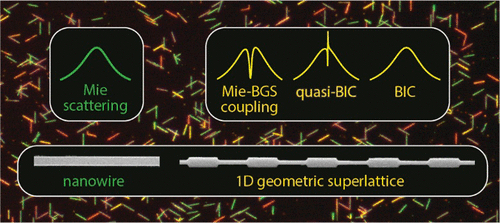当前位置:
X-MOL 学术
›
Acc. Chem. Res.
›
论文详情
Our official English website, www.x-mol.net, welcomes your
feedback! (Note: you will need to create a separate account there.)
Geometric Nanophotonics: Light Management in Single Nanowires through Morphology.
Accounts of Chemical Research ( IF 16.4 ) Pub Date : 2019-12-04 , DOI: 10.1021/acs.accounts.9b00515 Seokhyoung Kim 1 , James F Cahoon 1
Accounts of Chemical Research ( IF 16.4 ) Pub Date : 2019-12-04 , DOI: 10.1021/acs.accounts.9b00515 Seokhyoung Kim 1 , James F Cahoon 1
Affiliation

|
Comprehensive control of light-matter interactions at the nanoscale is increasingly important for the development of miniaturized light-based technologies that have applications ranging from information processing to sensing. Control of light in nanoscale structures-the realm of nanophotonics-requires precise control of geometry on a few-nanometer length scale. From a chemist's perspective, bottom-up growth of nanoscale materials from chemical precursors offers a unique opportunity to design structures atom-by-atom that exhibit desired properties. In this Account, we describe our efforts to create chemically and morphologically precise Si nanowires (NWs) with designed nanophotonic properties using a vapor-liquid-solid (VLS) growth process. A synthetic technique termed "Encoded Nanowire Growth and Appearance through VLS and Etching" (ENGRAVE) combines optimized VLS growth, dopant modulation, and dopant-dependent wet-chemical etching to produce NWs with precisely designed diameter modulations, yielding lithographic-like morphological control that can vary from sinusoids to fractals. The ENGRAVE NWs thus provide a versatile playground for coupling, trapping, and directing light in a nanoscale geometry. Previously, the nanophotonic functionality of NWs primarily relied on uniform-diameter structures that exhibit Mie scattering resonances and longitudinally oriented guided modes, two key photonic properties that typically cannot be utilized simultaneously due to their orthogonality. However, when the NW diameter is controllably modulated along the longitudinal axis on a scale comparable to the wavelength of light-a geometry we term a geometric superlattice (GSL)-we found that NWs can exhibit a much richer and tunable set of nanophotonic properties, as described herein. To understand these unique properties, we first summarize the basic optical properties of uniform-diameter NWs using Mie scattering theory and dispersion relations, and we describe both conventional and relatively new microscopy methods that experimentally probe the optical properties of single NWs. Next, delving into the properties of NW GSLs, we summarize their ability to couple a Mie resonance with a guided mode at a select wavevector (or wavelength) dictated by their geometric pitch. The coupling forms a bound guided state (BGS) with a standing wave profile, which allows a NW GSL to serve as a spectrally selective light coupler and to act as optical switch or sensor. We also summarize the capacity of a GSL to trap light by serving as an ultrahigh (theoretically infinite) quality factor optical cavity with an optical bound state in the continuum (BIC), in which destructive interference prevents coupling to and from the far field. Finally, we discuss a future research outlook for using ENGRAVE NWs for nanoscale light control. For instance, we highlight research avenues that could yield light-emitting devices by interfacing a NW-based BIC with emissive materials such as quantum dots, 2D materials, and hybrid perovskite. We also discuss the design of photonic band gaps, generation of high-harmonics with quasi-BIC structures, and the possibility for undiscovered nanophotonic properties and phenomena through more complex ENGRAVE geometric designs.
中文翻译:

几何纳米光子学:通过形态学对单个纳米线的光管理。
纳米尺度的光-物质相互作用的全面控制对于开发小型化的基于光的技术变得越来越重要,该技术的应用范围从信息处理到传感。控制纳米级结构中的光-纳米光子学的领域-需要在几纳米长的尺度上精确控制几何形状。从化学家的角度来看,从化学前体中自底向上生长纳米级材料提供了独特的机会来逐个原子地设计具有所需特性的结构。在此帐户中,我们描述了我们使用汽-液-固(VLS)生长过程创建具有设计的纳米光子特性的化学和形态精确的Si纳米线(NW)的努力。一种合成技术,称为“通过VLS和蚀刻进行编码的纳米线生长和外观” (ENGRAVE)将优化的VLS生长,掺杂剂调制和依赖于掺杂剂的湿法化学蚀刻相结合,以生产具有精确设计的直径调制的NW,从而产生了可从正弦曲线到分形变化的类似光刻的形态控制。因此,ENGRAVE NW提供了一个多功能的运动场,用于以纳米级的几何形状耦合,捕获和引导光。以前,NWs的纳米光子功能主要依赖于表现出Mie散射共振和纵向取向的导模的均匀直径结构,这两个关键的光子特性由于其正交性而通常无法同时利用。然而,当将NW直径沿纵轴以与光的波长相当的比例可控地调制时-一种几何形状,我们称其为几何超晶格(GSL)-我们发现,NW可以展现出更丰富和可调的纳米光子特性集,如下所述在此处。为了了解这些独特的特性,我们首先使用Mie散射理论和色散关系总结了均匀直径NW的基本光学特性,并描述了常规和相对较新的显微镜方法,它们通过实验方法探测了单个NW的光学特性。接下来,深入研究NW GSL的特性,我们总结了它们在由几何节距决定的选定波矢(或波长)下将Mie共振与引导模式耦合的能力。耦合形成具有驻波轮廓的边界引导状态(BGS),NW GSL可以用作光谱选择性光耦合器,并可以用作光开关或传感器。我们还总结了GSL通过用作超高(理论上是无限的)品质因数光学腔体(在连续体(BIC)中具有光学束缚态)捕获光的能力,其中相消干涉阻止了与远场的耦合。最后,我们讨论了使用ENGRAVE NW进行纳米级光控制的未来研究前景。例如,我们重点介绍了通过将基于NW的BIC与发光材料(例如量子点,2D材料和钙钛矿杂化材料)连接起来可以产生发光器件的研究途径。我们还将讨论光子带隙的设计,具有准BIC结构的高谐波的产生,
更新日期:2019-12-04
中文翻译:

几何纳米光子学:通过形态学对单个纳米线的光管理。
纳米尺度的光-物质相互作用的全面控制对于开发小型化的基于光的技术变得越来越重要,该技术的应用范围从信息处理到传感。控制纳米级结构中的光-纳米光子学的领域-需要在几纳米长的尺度上精确控制几何形状。从化学家的角度来看,从化学前体中自底向上生长纳米级材料提供了独特的机会来逐个原子地设计具有所需特性的结构。在此帐户中,我们描述了我们使用汽-液-固(VLS)生长过程创建具有设计的纳米光子特性的化学和形态精确的Si纳米线(NW)的努力。一种合成技术,称为“通过VLS和蚀刻进行编码的纳米线生长和外观” (ENGRAVE)将优化的VLS生长,掺杂剂调制和依赖于掺杂剂的湿法化学蚀刻相结合,以生产具有精确设计的直径调制的NW,从而产生了可从正弦曲线到分形变化的类似光刻的形态控制。因此,ENGRAVE NW提供了一个多功能的运动场,用于以纳米级的几何形状耦合,捕获和引导光。以前,NWs的纳米光子功能主要依赖于表现出Mie散射共振和纵向取向的导模的均匀直径结构,这两个关键的光子特性由于其正交性而通常无法同时利用。然而,当将NW直径沿纵轴以与光的波长相当的比例可控地调制时-一种几何形状,我们称其为几何超晶格(GSL)-我们发现,NW可以展现出更丰富和可调的纳米光子特性集,如下所述在此处。为了了解这些独特的特性,我们首先使用Mie散射理论和色散关系总结了均匀直径NW的基本光学特性,并描述了常规和相对较新的显微镜方法,它们通过实验方法探测了单个NW的光学特性。接下来,深入研究NW GSL的特性,我们总结了它们在由几何节距决定的选定波矢(或波长)下将Mie共振与引导模式耦合的能力。耦合形成具有驻波轮廓的边界引导状态(BGS),NW GSL可以用作光谱选择性光耦合器,并可以用作光开关或传感器。我们还总结了GSL通过用作超高(理论上是无限的)品质因数光学腔体(在连续体(BIC)中具有光学束缚态)捕获光的能力,其中相消干涉阻止了与远场的耦合。最后,我们讨论了使用ENGRAVE NW进行纳米级光控制的未来研究前景。例如,我们重点介绍了通过将基于NW的BIC与发光材料(例如量子点,2D材料和钙钛矿杂化材料)连接起来可以产生发光器件的研究途径。我们还将讨论光子带隙的设计,具有准BIC结构的高谐波的产生,











































 京公网安备 11010802027423号
京公网安备 11010802027423号